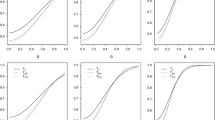Abstract
In the paper, the problem of how much a single contaminant can increase the size of the Student and theANOVA test is discussed. Exact upper bounds for the size of the tests are given. Numerical results are presented.
Similar content being viewed by others
References
M. Atiqullah, “The estimation of residual variance in quadratically balanced least-squares problems and the robustness of theF-test,”Biometrika,49, 83–91 (1962).
Y. Benjamini, “Is thet test really conservative when the parent distribution is long-tailed?”J. Amer. Statist. Assoc.,78, 645–654 (1983).
H. Hotelling, “The behavior of some standard statistical tests under nonstandard conditions,” in:Proceedings of the Fourth Berkeley Symposium, held June 20–30, 1960, Vol. I (1961).
E. S. Pearson, “The analysis of variance in the case of nonnormal variation,”Biometrika,23, 114–133 (1931).
R. Zieliński,One-Sample One-Sided Student t Test under Contaminants, Institute of Mathematics, Polish Academy of Sciences, Preprint 530 (1995).
Author information
Authors and Affiliations
Additional information
Proceedings of the XVII Seminar on Stability Problems for Stochastic Models, Kazan, Russia, 1995, Part I.
Rights and permissions
About this article
Cite this article
Berkoun, Y., Fellag, H., Ibazizen, M. et al. Maximal size of the Student and the ANOVA tests under exactly one contaminant. J Math Sci 81, 2900–2904 (1996). https://doi.org/10.1007/BF02362500
Issue Date:
DOI: https://doi.org/10.1007/BF02362500




